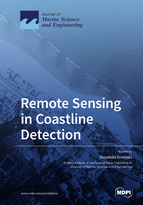Remote Sensing in Coastline Detection
A special issue of Journal of Marine Science and Engineering (ISSN 2077-1312).
Deadline for manuscript submissions: closed (10 December 2019) | Viewed by 29185
Special Issue Editor
Interests: geomatic; GNSS; UAV photogrammetry
Special Issues, Collections and Topics in MDPI journals
Special Issue Information
Dear Colleagues,
The coastal environment is a dynamic ecosystem, where the phenomena of erosion are influenced by numerous factors, such as meteorological/climatic, geological, biological and anthropic. This erosion has worrying effects on the environment, infrastructure, life-lines, and buildings; furthermore, climate change is exacerbating an already fragile situation. We are witnessing a high-risk situation and we are convinced that this is the most appropriate time to focus on the state-of-the-art of remote sensing techniques for shoreline monitoring. The improvements in the spatial and spectral resolution of current and next generation satellite-based sensors and the significant progress in the spatial data processing identify the Remote Sensing techniques to allow for a further step forward our knowledge of territory and the coast line. This Special Issue aims to highlight an overview of all multiscale remote sensing techniques (high resolution images, photogrammetry, SAR, etc.) and a whole array of methods and techniques for the processing, analysis and discussion of multitemporal remotely sensed data.
Prof. Dr. Donatella Dominici
Guest Editor
Manuscript Submission Information
Manuscripts should be submitted online at www.mdpi.com by registering and logging in to this website. Once you are registered, click here to go to the submission form. Manuscripts can be submitted until the deadline. All submissions that pass pre-check are peer-reviewed. Accepted papers will be published continuously in the journal (as soon as accepted) and will be listed together on the special issue website. Research articles, review articles as well as short communications are invited. For planned papers, a title and short abstract (about 100 words) can be sent to the Editorial Office for announcement on this website.
Submitted manuscripts should not have been published previously, nor be under consideration for publication elsewhere (except conference proceedings papers). All manuscripts are thoroughly refereed through a single-blind peer-review process. A guide for authors and other relevant information for submission of manuscripts is available on the Instructions for Authors page. Journal of Marine Science and Engineering is an international peer-reviewed open access monthly journal published by MDPI.
Please visit the Instructions for Authors page before submitting a manuscript. The Article Processing Charge (APC) for publication in this open access journal is 2600 CHF (Swiss Francs). Submitted papers should be well formatted and use good English. Authors may use MDPI's English editing service prior to publication or during author revisions.
Keywords
- climate change
- shoreline detection
- remote sensing
- monitoring






